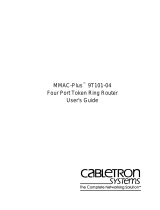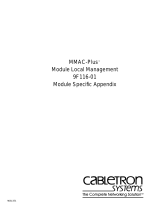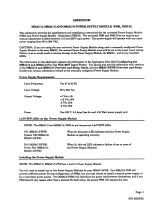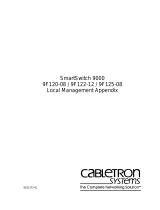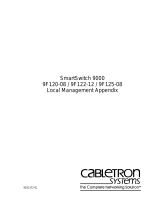Page is loading ...

MMAC-Plus
™
9F106-01
Two Port FDDI Router
User’s Guide

i
Notice
Notice
Cabletron Systems reserves the right to make changes in specifications and other information
contained in this document without prior notice. The reader should in all cases consult Cabletron
Systems to determine whether any such changes have been made.
The hardware, firmware, or software described in this manual is subject to change without notice.
IN NO EVENT SHALL CABLETRON SYSTEMS BE LIABLE FOR ANY INCIDENTAL, INDIRECT,
SPECIAL, OR CONSEQUENTIAL DAMAGES WHATSOEVER (INCLUDING BUT NOT LIMITED
TO LOST PROFITS) ARISING OUT OF OR RELATED TO THIS MANUAL OR THE INFORMATION
CONTAINED IN IT, EVEN IF CABLETRON SYSTEMS HAS BEEN ADVISED OF, KNOWN, OR
SHOULD HAVE KNOWN, THE POSSIBILITY OF SUCH DAMAGES.
© Copyright August 1995 by:
Cabletron Systems, Inc.
35 Industrial Way
Rochester, NH 03867-5005
All Rights Reserved
Printed in the United States of America
Order Number: 9031521 Aug 1995
MMAC-Plus
is a trademark of Cabletron Systems, Inc.
Cisco Systems
is a trademark of Cisco Systems, Inc.
CompuServe
is a registered trademark of CompuServe, Inc.

ii
Notice
FCC Notice
This device complies with Part 15 of the FCC rules. Operation is subject to the following two
conditions: (1) this device may not cause harmful interference, and (2) this device must accept any
interference received, including interference that may cause undesired operation.
NOTE:
This equipment has been tested and found to comply with the limits for a Class A digital
device, pursuant to Part 15 of the FCC rules. These limits are designed to provide reasonable
protection against harmful interference when the equipment is operated in a commercial environment.
This equipment uses, generates, and can radiate radio frequency energy and if not installed in
accordance with the operator’s manual, may cause harmful interference to radio communications.
Operation of this equipment in a residential area is likely to cause interference in which case the user
will be required to correct the interference at his own expense.
WARNING:
Changes or modifications made to this device which are not expressly approved by the
party responsible for compliance could void the user’s authority to operate the equipment.
VCCI Notice
This equipment is in the 1st Class Category (information equipment to be used in commercial and/or
industrial areas) and conforms to the standards set by the Voluntary Control Council for Interference
by Information Technology Equipment (VCCI) aimed at preventing radio interference in commercial
and/or industrial areas.
Consequently, when used in a residential area or in an adjacent area thereto, radio interference may be
caused to radios and TV receivers, etc.
Read the instructions for correct handling.

iii
Notice
DOC Notice
This digital apparatus does not exceed the Class A limits for radio noise emissions from digital
apparatus set out in the Radio Interference Regulations of the Canadian Department of
Communications.
Le présent appareil numérique n’émet pas de bruits radioélectriques dépassant les limites applicables
aux appareils numériques de la class A prescrites dans le Règlement sur le brouillage radioélectrique
édicté par le ministère des Communications du Canada.

v
Contents
Chapter 1 Introduction
Features........................................................................................................................... 1-1
Related Manuals............................................................................................................ 1-4
Getting Help ..................................................................................................................1-4
Chapter 2 Installing the MMAC-Plus Module
The Reset Switch ........................................................................................................... 2-3
Local Management Console ........................................................................................ 2-3
Installing an FPIM......................................................................................................... 2-6
Chapter 3 Operation
Flexible Network Bus (FNB)........................................................................................ 3-2
System Management Buses ......................................................................................... 3-2
System Diagnostic Controller...................................................................................... 3-2
DC/DC Converter ........................................................................................................ 3-2
FNB Interface................................................................................................................. 3-3
CPU ................................................................................................................................. 3-3
Chapter 4 LANVIEW LEDs
Chapter 5 Specifications
Safety............................................................................................................................... 5-1
Service............................................................................................................................. 5-1
Physical........................................................................................................................... 5-2
Dimensions ............................................................................................................. 5-2
Weight...................................................................................................................... 5-2
Environment...........................................................................................................5-2
Appendix A FPIM Specifications
FPIM-00 .........................................................................................................................A-1
FPIM-02 and FPIM-04..................................................................................................A-2
FPIM-05 .........................................................................................................................A-3

1-1
Chapter 1
Introduction
The 9F106-01 module, shown in Figure 1-1, is a two port FDDI router. One front
panel network connection can be made to this module and routed to any other
MMAC-Plus module via the FNB bus.
Features
Processor
The 9F106-01 is equipped with an advanced IDT R4600 Fourth Generation 64 bit
RISC microprocessor. This microprocessor provides a platform for all
management functions within a scalable RISC-based architecture.
System Management
The 9F106-01 provides an interface to the System Management Bus (SMB-1) for
intermodule management.
Connectivity
The 9F106-01 provides one dual attached FDDI interface using two standard
Cabletron FPIMs.
Routing
The 9F106-01 provides Routing between the front panel interface and/or to any
other module in the chassis via FNB -1 or FNB -2 of the FNB bus. IEEE 802.1d
Spanning Tree Protocol is supported in all bridging functions.

Introduction
1-2
Management Information Base (MIB) Support
The 9F106-01 module provides MIB support including the following:
• IETF FDDI MIB
• IETF MIB II
LANVIEW LEDs
The 9F106-01 uses LANVIEW: the Cabletron Systems built-in visual diagnostic
and status monitoring system. With LANVIEW LEDs, you can quickly identify
the device, port, and physical layer status at a glance.
Hot Swapping
The 9F106-01 can be installed or removed from the chassis while the MMAC-Plus
is powered up without affecting the operation of the remaining modules in the
chassis.
For a complete list of supported MIBs, refer to the release notes provided in the
module package.
NOTE

1-3
Features
Figure 1-1. The 9F106-01 Module
0
FPIM 1FPIM 1
FPIM 1
MMAC PLUS

Introduction
1-4
Related Manuals
The manuals listed below should be used to supplement the procedures and
technical data contained in this manual.
MMAC-Plus Installation Guide
MMAC-Plus Operations Guide
MMAC-Plus 9C300-1 Environmental Module User’s Guide
MMAC-Plus 9C214-1 AC Power Supply User’s Guide
Cisco Systems R4500 manuals - CRM-DOC or CRM-CDROM
Getting Help
If you need additional support with the MMAC-Plus, or if you have any
questions, comments or suggestions concerning this manual, feel free to contact
Cabletron Systems Technical Support:
By phone: (603) 332-9400
By CompuServe
®
: GO CTRON from any ! prompt
By Internet mail: [email protected]
By mail: Cabletron Systems, Inc.
P.O. Box 5005
Rochester, NH 03867-0505

2-1
Chapter 2
Installing the MMAC-Plus Module
The MMAC-Plus module may be installed into any of the 14 slots that are
available. To install, follow the steps below:
1. Remove the blank panel, covering the slot that the module is being mounted
in. All other slots must be covered, if modules are not being installed, to
ensure proper airflow and cooling.
2. Carefully remove the module from the shipping box. (Save the box and
packing materials in the event the module must be reshipped.)
3. Attach one end of the ESD wrist strap packaged with the MMAC-Plus chassis
to your wrist. Plug the other end into the ESD Wrist Strap Grounding
receptacle in the lower right corner of the MMAC-Plus Chassis shown in
Figure 1.
4. Remove the module from the plastic bag. Observe all precautions to prevent
damage from Electrostatic Discharge (ESD).
5. Carefully examine the module, checking for damage. If any damage exists,
DO NOT install the module. Contact Cabletron Systems Technical Support
immediately.
6. Before installing the MMAC-Plus cards into the chassis, ensure that the
bottom and top plastic tabs are unlocked. Slide the card into an available slot
and ensure that the circuit card is between the card guides, as shown in
Figure 1. Check both the upper and lower tracks. Take care that the module
slides in straight and engages the backplane connectors properly. Lock down
the top and bottom plastic tabs at the same time, applying even pr
essure.

Installing the MMAC-Plus Module
2-2
Figure 2-1. Installing the MMAC-Plus Module
7
FLNK
8
FLNK
FLNK
10
FLNK
INS
11
FLNK
INS
12
RX
TX
RX
TX
RX
Circuit Card
Card Guides
Metal Back-Panel
Jack for ESD
wrist strap
Plastic Tabs
Warning:
Ensure that the circuit card is between the card guides.
Lock down the top and bottom plastic tabs
at the same time, applying even pressure.

2-3
The Reset Switch
The Reset Switch
The Reset switch is located on the front panel, under the top plastic tab, as shown
in Figure 2-2. It serves two functions:
• Pressing the Reset switch twice within three seconds causes the processor to
reset.
• Pressing and holding the switch on for three or more seconds causes the
module to shutdown. Pressing and holding again for three seconds restarts the
module.
SNMP management may be used to disable this switch to enhance module
security.
Figure 2-2. The Reset Switch
Local Management Console
Local Management is accessed by attaching a management console at the RJ-45
CON port of the 9F106-01. The console connection supports a Digital Equipment
Corporation VT 320™ terminal or PC emulation of one of these terminals.
Table 2-1 lists the setup requirements for the local management console. If your
terminal is a Digital Equipment Corporation VT 320™ terminal, press
F3
to access
the Setup Directory. If you have a terminal emulation of the Digital Equipment
terminals, refer to your equipment user manual for setup procedures.
Reset Switch

Installing the MMAC-Plus Module
2-4
Table 2-1. Terminal Setup Requirements
Menu Function Selection
Display Columns 80 Columns
Setup: Controls Interpret Controls
Auto Wrap No Auto Wrap
Text Cursor Cursor
General Mode 7 Bit Control
Setup:
Cursor Keys Normal Cursor
Keys
Communications
Setup: Transmit Transmit = 9600
Receive Receive = Transmit
XOFF any option
Bits, Parity 8 Bits, No Parity
Stop Bit 1 Stop Bit
Local Echo No Local Echo
Port EIA Port, Data Leads
Only
DEC-423, Data
Leads only
Transmit any option
Auto Answerback No Auto Answerback
Keyboard Auto Repeat any option
Setup: Keyclick any option
Margin Bell Margin Bell
Warning Bell Warning Bell
Auto Answerback No Auto Answerback

2-5
Local Management Console
An RJ-45 connector provides a CON interface to the management terminal.
Figure 2-3 shows the pinouts.
Figure 2-3. Console Cable Pinouts
Connect the console to the module as follows:
1. Attach the male RJ-45 connector to the CON port of the 9F106-01.
2. Attach the female end (25-pin or 9-pin, as applicable) to the terminal.
Refer to the Cisco Systems documentation for information on configuring this
module.
Pin 1
RJ-45 CON PORT
CLEAR TO SEND
2
3
5
7
RECEIVE
TRANSMIT
SIGNAL GROUND
RJ-45 TO 25 PIN
CABLE
FEMALE - 25 Pin
"D" Shell Connector
20 DATA TERMINAL READY
4
1
5
2
6
TRANSMIT
RECEIVE
DATA SET READY
DATA TERMINAL READY
SIGNAL GROUND
C ON PORT
R J-45
LOCAL MANAGENT
CONSOLE
RECEIVE
TRANSMIT
SIGNAL GROUND
RJ-45 TO 9 PIN
CABLE
FEMALE - DB-9
(9-Pin Connector)
3
2
5
8
DATA SET READY
1
4
5
2
6
TRANSMIT
RECEIVE
SIGNAL GROUND
7
DATA TERMINAL READY
CLEAR TO SEND
READY TO SEND

Installing the MMAC-Plus Module
2-6
Installing an FPIM
The 9F106-01 module is shipped without FPIMs. To install an FPIM, follow the
procedure below:
1. Remove the module if it is installed in the MMAC-Plus chassis.
2. Remove the blank front cover over the FPIM slot.
3. Install the FPIM as shown in Figure 2-4. Ensure that the rear connector is
seated firmly before tightening the two mounting screws.
Figure 2-4. Installing an FPIM

3-1
Chapter 3
Operation
The 9F106-01 FDDI module is a two port router for the MMAC-Plus. One front
panel network connection can be made to this module and routed to any other
MMAC-Plus module via the FNB bus.
Figure 3-1. 9F106-01 Block Diagram
CPU
FNB-1 or
FNB-2
System
Diagnostic
Controller
SMB-1
DC/DC
Converter
Front Panel CON Ports
DAS
Interface
A
B

Operation
3-2
Flexible Network Bus (FNB)
The FNB consists of two dual FDDI networks, the FNB-1 and FNB-2, providing
up to 400 Mbps of data bandwidth. These FDDI networks are 100% ANSI FDDI-
compliant, supporting SMT (version 7.3), MAC, PHY, and PMD standards. This
allows the FNB to traverse multiple MMAC-Plus hubs, or connect to any ANSI
FDDI-compliant device, through standard A/B port connections.
System Management Buses
The SMB-1 is a 1 Mbps management bus located within the MMAC-Plus. This bus
is utilized by all diagnostic controllers in the system. These include connectivity
modules, power supply modules, and the environmental module. The SMB-1
transports inter-chassis information between system components, such as power
and environmental information, as well as diagnostic messages. Periodic
loop-back tests are performed by all modules that share this bus to ensure the
validity of SMB-1.
System Diagnostic Controller
This diagnostic controller is composed of a Z-80 microprocessor and its
supporting logic. The diagnostic controller is designed to control the power-up
sequencing of modules, monitor the 9F106-01 input and output power
parameters, keep watch over the main host processor, as well as monitor the
temperature and control the SMB LANVIEW diagnostic LED. The information
gathered by the diagnostic controller is available to the network manager via
local/remote management and the LCD located on the Environmental Module.
The 9F106-01 have been designed so that in the event of a diagnostic controller
fault, the modules will continue to function.
DC/DC Converter
The DC/DC converter converts the 48 VDC on the system power bus to the
necessary operating voltages for its host network services module. The diagnostic
controller controls the operation of the DC/DC converter.

3-3
FNB Interface
FNB Interface
MMAC-Plus modules are designed with one of two attachment policies. One
allows dual attachment of a module to either FNB-1 or FNB-2; the second allows
dual attachment to both FNB-1 and FNB-2. The 9F106-01 has one dual attachment
to the FNB backplane, connecting to either FNB-1 or FNB-2. The module can
insert into the FNB or bypass it. These flexible configuration options make the
MMAC-Plus ideal for networks designed to Bridge/Route multiple lower speed
LANs to FDDI and/or networks designed using an FDDI collapsed backbone.
CPU
The CPU provides all forwarding/filtering decisions, the SNMP protocol stacks,
as well as support for industry standard MIBs.

LANVIEW LEDs
4-2
The functions of the System Management Bus (SMB) and CPU LEDs are listed in
Table 4-1.
* Front Panel FDDI down.
The function of the FNB Receive LED is listed in Table 4-2.
The function of the FNB Transmit LED is listed in Table 4-3.
Table 4-1. SMB and CPU LEDs
LED Color
State Description
Green Functional Fully operational.
Yellow (Flashing) Crippled Conditional FDDI fault *.
Yellow Booting Booting.
Red Reset Normal power-up reset.
Red (Flashing) Failed FDDI Fault (FNB is down).
Off Power off Module powered off.
Table 4-2. FNB Receive LED
LED Color
State
Yellow (Flashing) Activity (Flashing rate indicates rate of activity).
Off No activity
Table 4-3. FNB Transmit LED
LED Color
State
Green (Flashing) Activity (Flashing rate indicates rate of activity).
Off No activity
/

